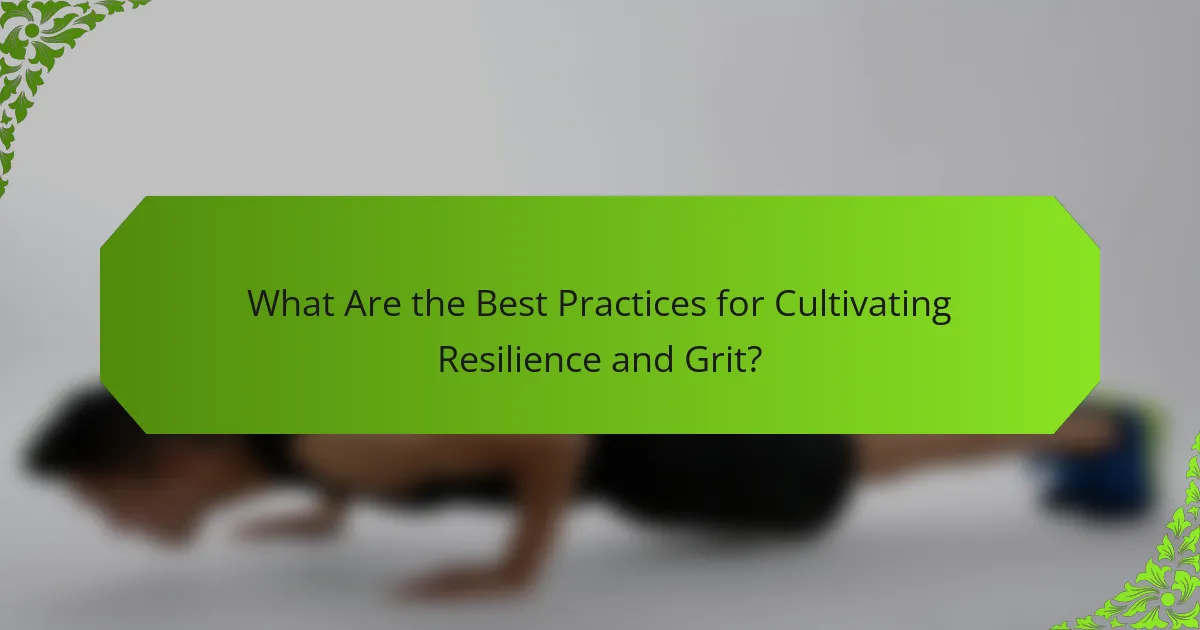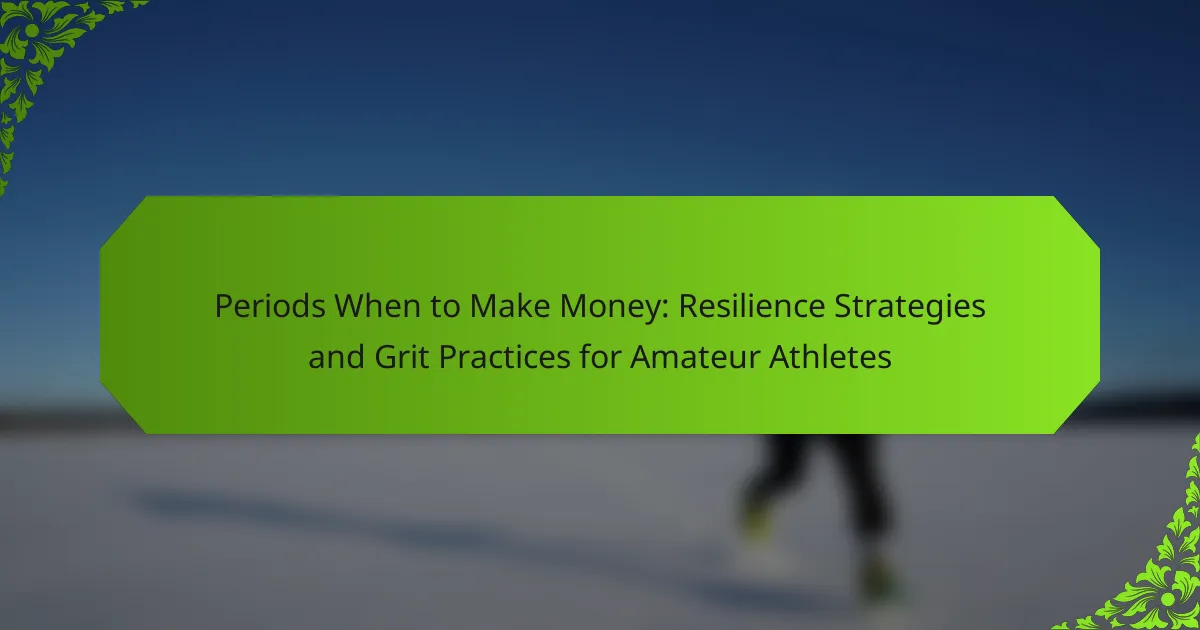Building resilience and grit is crucial for amateur athletes to enhance performance and mental well-being. This article explores the significance of resilience, universal practices to foster it, and unique strategies for developing grit. It also addresses rare attributes that contribute to long-term resilience and common mistakes athletes make that hinder their progress. By focusing on these elements, athletes can effectively navigate challenges and achieve their goals.

How Does Resilience Impact Amateur Athletes?
Resilience significantly enhances amateur athletes’ performance and mental well-being. It fosters perseverance, enabling them to overcome challenges and setbacks. Resilient athletes often exhibit higher motivation and commitment, which contributes to their overall success in sports. Studies show that resilience correlates with improved coping strategies and lower anxiety levels during competition. This unique attribute allows athletes to maintain focus under pressure, ultimately leading to better outcomes and personal growth.
What Are the Key Characteristics of Resilience?
Resilience in amateur athletes is characterized by adaptability, perseverance, mental toughness, and emotional regulation. These traits enable athletes to overcome challenges and setbacks effectively. Adaptability allows athletes to adjust strategies, while perseverance ensures they persist despite obstacles. Mental toughness fosters focus and confidence, and emotional regulation helps manage stress and anxiety. Together, these characteristics form a robust framework for building resilience and grit in sports.
Why Is Grit Essential for Athletic Success?
Grit is essential for athletic success because it fosters perseverance and resilience in the face of challenges. Athletes with grit demonstrate a commitment to long-term goals, which enhances their performance over time. Research indicates that grit correlates strongly with achievement in sports, as it enables athletes to push through setbacks. This unique attribute of grit allows amateur athletes to develop skills and mental toughness, ultimately leading to improved competition results.

What Universal Practices Foster Resilience in Sports?
Universal practices that foster resilience in sports include consistent training, mental conditioning, and supportive environments. These elements help amateur athletes develop grit and perseverance. Training routines instill discipline, while mental conditioning techniques such as visualization enhance focus. Supportive environments, including positive coaching and teamwork, encourage athletes to overcome challenges. Collectively, these practices build a strong foundation for resilience in sports, enabling athletes to navigate setbacks effectively.
How Can Goal Setting Enhance Resilience?
Goal setting enhances resilience by providing clear objectives, fostering motivation, and promoting a sense of achievement. When amateur athletes set specific, measurable goals, they develop grit, which helps them navigate challenges and setbacks. This process builds mental toughness, allowing them to persist despite difficulties. Research indicates that athletes with defined goals demonstrate higher resilience levels, adapting better to stress and maintaining focus on long-term success.
What Role Does Positive Self-Talk Play?
Positive self-talk significantly enhances resilience in amateur athletes. It fosters a growth mindset, enabling them to overcome challenges. Positive affirmations can reduce anxiety and improve performance. Studies show that athletes who engage in constructive self-dialogue exhibit greater perseverance and grit during competitions. This mental strategy empowers athletes to maintain focus and motivation despite setbacks, ultimately leading to improved outcomes.

What Unique Strategies Build Grit in Amateur Athletes?
Building grit in amateur athletes involves unique strategies that foster resilience and determination. Key approaches include setting specific goals, cultivating a growth mindset, and implementing consistent training routines.
1. **Goal Setting**: Establish clear, measurable objectives that challenge athletes while remaining attainable. This creates a sense of purpose and direction.
2. **Growth Mindset**: Encourage athletes to view challenges as opportunities for learning. This mindset helps them embrace setbacks as part of their development.
3. **Consistent Training**: Develop a structured training schedule that includes both physical and mental exercises. Regular practice builds habits that reinforce grit.
4. **Positive Reinforcement**: Use encouragement and constructive feedback to motivate athletes. Recognizing their efforts fosters a resilient attitude.
5. **Peer Support**: Promote a supportive team environment where athletes can share experiences and motivate each other. This camaraderie strengthens their resolve.
By integrating these unique strategies, amateur athletes can build the resilience necessary to overcome obstacles and excel in their sports.
How Can Visualization Techniques Improve Performance?
Visualization techniques can significantly enhance performance by improving focus and mental resilience. These techniques help athletes mentally rehearse their movements, leading to better execution during competitions. Research shows that athletes who regularly use visualization report increased confidence and reduced anxiety, which are critical for optimal performance. By creating vivid mental images of success, athletes can build grit and resilience, enabling them to overcome challenges and setbacks. This mental training is essential for amateur athletes striving to improve their skills and achieve their goals.
What Are the Benefits of Embracing Challenges?
Embracing challenges fosters resilience and grit in amateur athletes, enhancing their overall performance. It cultivates problem-solving skills, boosts confidence, and promotes adaptability. Athletes learn to manage stress and setbacks, which are inherent in competitive sports. This growth mindset leads to improved mental toughness, empowering them to face future obstacles with determination. Research shows that athletes who embrace challenges tend to achieve higher levels of success and satisfaction in their sports.
What Steps Can Athletes Take to Face Adversity?
Athletes can build resilience by practicing mental toughness, developing a support system, and learning from failures. These steps foster grit and enhance performance under pressure.
1. Embrace challenges: View setbacks as opportunities to grow.
2. Set realistic goals: Break down larger objectives into manageable tasks.
3. Cultivate a support network: Engage coaches, teammates, and mentors for guidance.
4. Practice mindfulness: Use techniques like meditation to maintain focus and reduce anxiety.
5. Reflect on experiences: Analyze past adversities to identify lessons learned.

What Rare Attributes Contribute to Long-Term Resilience?
Rare attributes that contribute to long-term resilience in amateur athletes include adaptability, emotional intelligence, and intrinsic motivation. Adaptability allows athletes to adjust strategies in response to challenges. Emotional intelligence fosters strong relationships and effective communication, enhancing support systems. Intrinsic motivation drives persistence and commitment, essential for overcoming setbacks. These attributes create a robust foundation for sustained resilience in sports.
How Does Emotional Intelligence Influence Grit?
Emotional intelligence significantly enhances grit by fostering resilience and self-regulation. Athletes with high emotional intelligence can better manage stress, maintain motivation, and recover from setbacks. This unique attribute allows them to persevere through challenges, ultimately leading to improved performance. Studies indicate that emotional intelligence contributes to a 20% increase in resilience among amateur athletes, underscoring its critical role in developing grit.
What Is the Impact of Community Support on Resilience?
Community support significantly enhances resilience in amateur athletes by fostering a sense of belonging and motivation. Supportive environments encourage athletes to persist through challenges, ultimately improving their performance and mental well-being. Research shows that athletes with strong community ties exhibit greater grit, which is essential for overcoming obstacles. This emotional backing serves as a buffer against stress, enabling athletes to focus on their goals. Therefore, community support is a vital component in building resilience among amateur athletes.

How Can Amateur Athletes Measure Their Progress in Building Resilience?
Amateur athletes can measure their progress in building resilience through self-assessment, goal tracking, and feedback. Regularly reflecting on challenges faced and overcome helps gauge mental toughness. Setting specific, measurable goals allows athletes to track improvements over time. Additionally, seeking feedback from coaches or peers provides external perspectives on resilience development.
What Tools and Techniques Are Available for Self-Assessment?
Self-assessment tools and techniques for amateur athletes include journals, performance metrics, and feedback sessions. Journals help track progress and emotions, while performance metrics provide quantitative data on skills. Feedback sessions with coaches or peers offer insights into areas of improvement. These methods enhance resilience and grit by promoting self-awareness and accountability.

What Are the Common Mistakes Amateur Athletes Make in Developing Grit?
Amateur athletes often make mistakes that hinder their development of grit. Common errors include setting unrealistic expectations, neglecting mental training, and failing to embrace challenges. Many athletes underestimate the importance of consistency, leading to erratic training schedules. Additionally, they may avoid seeking feedback, which limits growth opportunities. Lastly, a lack of patience can cause premature burnout, stalling their journey toward resilience.
How Can Athletes Avoid Burnout While Building Resilience?
Athletes can avoid burnout and build resilience by implementing structured training, prioritizing rest, and fostering a supportive environment. Establishing a balanced routine helps manage stress and enhances mental fortitude. Regular breaks and mindfulness practices can refresh focus, while strong social support networks provide motivation and accountability.

What Are the Best Practices for Cultivating Resilience and Grit?
To cultivate resilience and grit in amateur athletes, focus on consistent practice, goal setting, and positive reinforcement. Encourage athletes to embrace challenges, learn from failures, and maintain a growth mindset. Establish a supportive environment that fosters teamwork and open communication. Regularly assess progress and celebrate achievements to build confidence.
How Can Coaches Support Athletes in This Journey?
Coaches can support athletes by fostering a positive environment, emphasizing mental strength, and providing personalized feedback. They should encourage open communication, helping athletes express challenges and fears. Regularly setting achievable goals builds resilience, while celebrating small victories enhances grit. Coaches can also incorporate mental training techniques, such as visualization and mindfulness, to equip athletes with tools for overcoming adversity. This holistic approach nurtures both emotional and physical development, crucial for long-term success.
What Daily Habits Foster a Resilient Mindset?
Daily habits that foster a resilient mindset include consistent goal setting, maintaining a positive attitude, and engaging in regular physical activity. These practices enhance grit in amateur athletes, enabling them to overcome challenges effectively.
1. Goal Setting: Establish clear, achievable objectives to provide direction and motivation.
2. Positive Affirmations: Use positive self-talk to reinforce confidence and resilience.
3. Physical Exercise: Incorporate regular workouts to boost mental and physical endurance.
4. Mindfulness Practices: Engage in meditation or deep breathing to manage stress and improve focus.
5. Social Support: Build a network of encouragement from coaches, peers, and family to foster resilience.
6. Reflection: Regularly assess experiences to learn from setbacks and celebrate successes.


